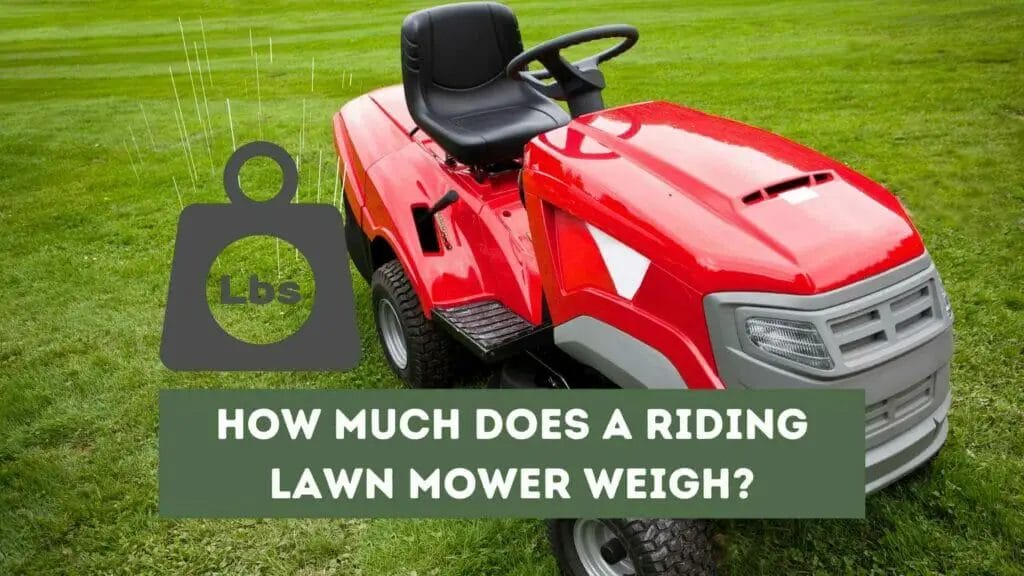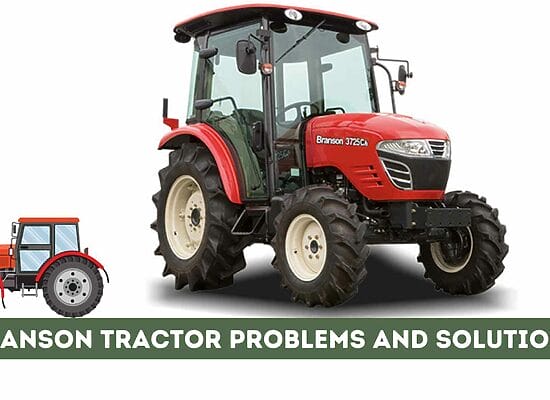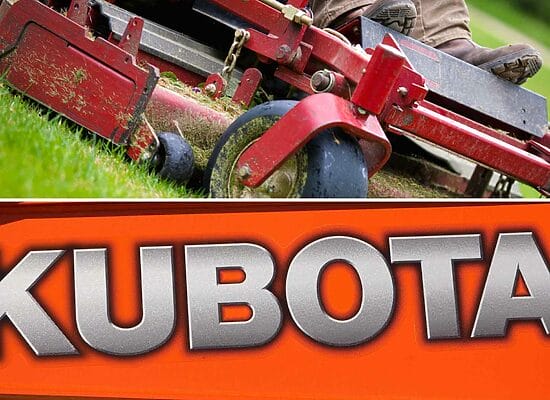
When it comes to maintaining a lawn, having the right tools can make all the difference. One of the most important tools you need is a riding lawn mower. However, before you invest in one, it’s important to know how much it weighs. After all, you don’t want to end up with a mower that’s too heavy for you to maneuver around your yard. But how much does a riding lawn mower weigh?
On average, riding lawn mowers weigh between 250-500 pounds, with commercial models weighing up to 800 pounds. However, the weight can vary depending on the size and model of the mower, as well as any attachments or accessories that are added to it. For instance, zero-turn machines are typically heavier, and they can reach 1,000 pounds or higher. Additionally, fuel adds weight to your riding lawn mower, with each gallon weighing 6.3 pounds.
Knowing how much your riding lawn mower weighs is important for a variety of reasons. It can help you determine if it’s the right fit for your needs and ensure that you can safely operate it. Additionally, it can be useful information if you need to transport your mower or store it in a specific location. So, whether you’re a seasoned pro or a first-time lawn mower owner, understanding the weight of your riding lawn mower is essential.
Key takeaways:
- Riding lawn mowers weigh between 250-500 pounds on average, with commercial models reaching up to 800 pounds.
- The weight can vary based on the size, model, and attachments of the mower.
- Zero-turn mowers are typically heavier, with weights of 1,000 pounds or more.
- Fuel adds weight to the mower, with each gallon weighing 6.3 pounds.
- Knowing the weight of your riding lawn mower is important for determining its suitability and safe operation.
- Different types of riding lawn mowers include zero-turn mowers and lawn tractors, each with its own features and weight ranges.
- Factors affecting the weight of a riding lawn mower include the size of the cutting deck, engine type, and additional features.
- Consider the weight of the mower for maneuverability, stability, transport, and fuel efficiency.
- Push mowers are generally lighter than riding mowers, weighing around 50-100 pounds.
- When purchasing a riding lawn mower, consider yard size, terrain, and budget to find the right mower for your needs.
Types of Riding Lawn Mowers
If you’re in the market for a riding lawn mower, you’ll quickly find that there are several different types to choose from. Here are two of the most common types:
Zero-Turn Mowers
Zero-turn mowers are known for their ability to turn on a dime, making them ideal for mowing around obstacles like trees and flower beds. They have two lap bars instead of a steering wheel, which allows you to control the mower’s speed and direction with your hands. Zero-turn mowers typically have a cutting width of 42 to 60 inches (106.7 to 152.4 centimeters) and can weigh up to 1,000 pounds (453.6 kilograms).
Lawn Tractors
Lawn tractors are the most common type of riding lawn mower. They have a steering wheel and pedals, just like a car, and are typically used for mowing large, flat lawns. Lawn tractors have a cutting width of 38 to 54 inches (96.5 to 137.2 centimeters) and can weigh between 400 and 800 pounds (181.4 to 362.9 kilograms).
Pro Tip: When choosing a lawn tractor make sure it has enough horsepower to handle the size of your lawn. A good rule of thumb is to have at least 1 horsepower for every 1,000 square feet of lawn.
Factors Affecting Riding Lawn Mower Weight
When it comes to riding lawn mowers, weight is an important consideration. The weight of a lawn mower can affect its performance, maneuverability, and stability. There are several factors that can contribute to the weight of a riding lawn mower.
Deck Size
The size of the cutting deck is one of the biggest factors that can affect the weight of a riding lawn mower. The larger the deck, the heavier the mower will be. A larger deck may be necessary for larger lawns, but it can also make the mower more difficult to maneuver.
Engine Type
The type of engine can also affect the weight of a riding lawn mower. Gas-powered mowers tend to be heavier than electric mowers because they have larger engines and more components. A gas engine mower can weigh anywhere from 300 to 900 pounds (136 to 408 kg), while an electric mower may weigh only 50 to 100 pounds (23 to 45 kg).
Additional Features
Additional features can also contribute to the weight of a riding lawn mower. For example, wheel weights can be added to increase traction and stability, but they also add weight to the mower. Other features, such as a bagging system or a mulching kit, can also add weight.
It’s important to consider all of these factors when choosing a riding lawn mower. A heavier mower may be more stable, but it may also be more difficult to maneuver. A lighter mower may be easier to handle, but it may not be as stable on uneven terrain.
Does the Weight of a Lawn Mower Matter?
When considering a lawn mower, weight may not be the first thing that comes to mind. However, the weight of a lawn mower can impact its performance and your ability to use it effectively. Here are a few things to keep in mind when it comes to the weight of your lawn mower:
- Maneuverability: A lighter lawn mower is generally easier to maneuver, especially in tight spaces or around obstacles. This can be especially important if you have a lot of trees, flower beds, or other landscaping features in your yard.
- Stability: On the other hand, a heavier lawn mower may be more stable and less likely to tip over on uneven terrain. This can be particularly important if you have hills or slopes in your yard.
- Transport: If you need to transport your lawn mower frequently, either in a vehicle or by hand, the weight can be a significant factor. A lighter lawn mower may be easier to lift and move, while a heavier one may require more effort.
- Fuel efficiency: The weight of a lawn mower can also impact its fuel efficiency. A heavier lawn mower may require more fuel to operate, which can add up over time.
Pro Tip: If you're in the market for a new lawn mower, consider trying out a few different models with varying weights to see what feels most comfortable and effective for you.
Average Weight of Riding Lawn Mowers
If you are in the market for a riding lawn mower, one of the most important factors to consider is the weight of the mower. Riding lawn mowers come in different weights, and it is crucial to know the average weight of a riding lawn mower to make an informed decision.
On average, a riding lawn mower weighs around 500 pounds. However, some models weigh less, while others are much heavier. For example, some of the heavier riding lawn mowers can weigh up to 1,000 pounds or more.
The weight of the mower is an essential consideration when it comes to maneuverability and ease of use. Heavier riding lawn mowers can be much harder to maneuver, especially around tight corners or in smaller spaces. On the other hand, lighter models are easier to handle and can be better suited for smaller lawns.
If you have a larger lawn, you may want to consider a heavier riding lawn mower. These models typically have more powerful engines and can handle more extensive mowing tasks. However, if you have a smaller lawn, a lighter-riding lawn mower may be more suitable.
It is also important to note that the weight of the lawn tractor’s deck and engine accounts for most of the mower’s weight. Bigger models tend to have larger decks and engines, which can make them much heavier.
Comparison with Push Lawn Mowers
When it comes to lawn mowers, you have two main options: push mowers and riding mowers. Push mowers are typically smaller, lighter, and less expensive than riding mowers. They are powered by an engine and require the operator to push them across the lawn. On the other hand, riding mowers are larger, heavier, and more expensive. They are equipped with an engine and a seat for the operator to sit on and drive the mower across the lawn.
One of the main differences between push mowers and riding mowers is their weight. Push mowers are generally much lighter than riding mowers. A typical push mower can weigh anywhere from 50 to 100 pounds, depending on the model. This makes them easy to maneuver and store, but also means they may not be as powerful or efficient as riding mowers.
In contrast, riding mowers can weigh anywhere from 300 to 800 pounds or more, depending on the size and features of the machine. The weight of a riding mower is largely due to its larger size, engine, and cutting deck. However, this weight can also make them more stable and easier to control on uneven terrain.
Another factor to consider when comparing push mowers and riding mowers is the type of power source they use. Push mowers are typically available in electric and gas-powered models while riding mowers are available in gas and battery-powered models. Electric and battery-powered mowers are generally lighter than gas-powered mowers, but they may not be as powerful or have as long a runtime.
It’s also worth noting that riding mowers tend to have larger wheels than push mowers, which can help them navigate rough or uneven terrain more easily. However, this can also make them more difficult to store or transport.
Factors to Consider When Purchasing a Riding Lawn Mower
When shopping for a new mower, there are several factors to consider to ensure you get the right one for your needs. Here are three key factors to keep in mind:
Yard Size
The size of your lawn is an important consideration when purchasing a riding lawn mower. If you have a smaller yard, a mower with a cutting deck of 30-42 inches will be sufficient. However, if you have a larger lawn, you will want a mower with a cutting deck of at least 42 inches to save time and effort.
Terrain
Another important factor to consider is the terrain of your lawn. If you have a flat lawn, a mower with rear wheels will be sufficient. However, if you have a hilly or uneven lawn, you will want a mower with gauge wheels to ensure an even cut. Additionally, if you have tight corners or obstacles to navigate, a zero-turn mower may be the best option.
Budget
Finally, your budget is an important consideration when purchasing a riding lawn mower. While electric mowers may be less expensive, they are not suitable for larger lawns or commercial use. Gas-powered mowers are more expensive but are better suited for larger lawns and commercial use.
FAQ: Riding Lawn Mower Weigh
How much does a riding lawn mower weigh?
The weight of a riding lawn mower varies depending on the type of mower and its features. On average, a riding lawn mower weighs between 300 to 600 pounds.
What is a riding lawn mower?
A riding lawn mower is a type of mower that designed for cutting grass on larger areas of lawn. It is a self-propelled machine that is driven by an operator who sits on a seat and operates the controls to guide the mower across the lawn.
What are the different types of riding lawn mowers?
There are several different types of riding lawn mowers available on the market, including zero-turn mowers, lawn tractors, garden tractors, and rear-engine mowers. Each type has its own unique features and benefits.
How does the weight of a riding lawn mower affect lawn care?
The weight of a riding lawn mower can impact the quality of your lawn care. Heavier mowers tend to leave less of a mark on the lawn, while lighter mowers may have trouble bouncing up and down in uneven terrain.
What is the weight limit for a riding mower?
The weight limit for a riding lawn mower typically depends on the specific model and manufacturer. Some larger, heavy-duty mowers may be able to support up to 600 pounds, while smaller models may have a lower weight limit.
How much does a John Deere riding lawn mower weigh?
John Deere offers a variety of different models of riding lawn mowers, ranging in weight from around 300 to 600 pounds.
What is a deck shell on a riding lawn mower?
The deck shell on a riding lawn mower is the protective metal covering that surrounds the mower’s cutting blade. It helps keep grass clippings and debris from flying out while also protecting the blade from damage.
What is the heaviest type of riding lawn mower?
The heaviest type of riding lawn mower is typically a heavy-duty zero-turn model designed for commercial lawn mowing. These machines can weigh up to 600 pounds or more.
Do electric models of riding lawn mowers weigh less?
Electric models of riding lawn mowers can weigh less than traditional gas-powered models, but this depends on the specific model and its features. Some electric models may have added weight from the battery.
How can I add extra weight to my riding lawn mower?
Adding extra weight to your riding lawn mower can help improve its traction and maneuverability. You can add weight by attaching weights to the mower’s frame or by filling the tires with fluid.












